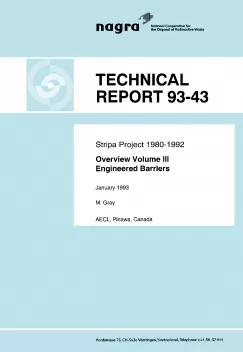
Technical Report NTB 93-43
Stripa Project 1980 – 1992Overview Volume IIIEngineered Barriers
The International Stripa Project was a cooperative research and development project among several member countries of the Nuclear Energy Agency of the Organization for Economic Cooperation and Development. The project, which started in 1980 and ended in 1992, was conducted under the auspices of the Nuclear Energy Agency. The project was managed by the Swedish Nuclear Fuel and Waste Management Company (SKB) under the direction of a Joint Technical Committee (JTC) composed of representatives from participating countries.
The scientific and technical objectives of the project were to investigate several aspects of technology concerned with the feasibility and safety of disposal of long-lived, heat-generating radioactive waste at depth in granitic rocks. In particular, the Stripa Project addressed:
- the development of instruments and procedures to characterize candidate repository sites;
- the understanding and modelling of groundwater flow and solute transport in fractured crystalline rock; and
- the design of engineered barriers capable of contributing to waste isolation by restricting groundwater flow in proximity to the waste containers and in the surrounding host rock.
Because the activities and the results of the Stripa Project have been reported in more than 170 technical reports, the JTC has decided that the final action of the project should be the publication of an overview report that would convey, in relatively concise form, the body of information produced by the project.
The overview report has been subdivided into three volumes:
I. Executive Summary
II. Natural Barriers
III. Engineered Barriers
The Executive Summary summarizes the contents of the other two volumes with the addition of some general considerations about the Stripa Project. The authors of the Executive Summary are the five members of the Overview Reporting Group, that was established by the JTC for the purpose of producing the overview report. The Overview Reporting Group consisted of the two authors of volumes II and III, Paul Gnirk and Malcolm Gray, respectively, and two outside reviewers, Charles Fairhurst and Ferruccio Gera. The Project manager, Bengt Stillborg, acted as coordinator.
Conclusions
- The hydraulic conductivity of drill holes and excavated openings could be returned to values similar to those of intact granite by the judicious use of HCB.
- Models are now available to predict the response of HCB to changes in stress, thermal and hydraulic gradients. The models for water transfer are not rigorously precise. In contrast, thermal properties are reasonably well understood and heat fluxes through the material can be well described.
- The properties of advanced, high-performance bentonite- and cement-based materials pertinent to their successful injection as grouts in fractured rock have been well defined. Equipment and procedures for injection of the grouts have been developed and are available for use in repository design and construction. The limits of the application of the selected materials and methodologies were defined for the Stripa granite.
- Data at the level of detail derived for the application and qualification of general groundwater flow models such as those examined in the natural barrier studies of the Stripa Project are unlikely to provide sufficient information for grouting activities intended for repository sealing. As at Stripa, the information gained from the grouting activities at repository sites will likely lead to revisions in understanding of the rock mass.
- An excavation disturbed zone (EDZ) consisting of a blast disturbed zone enveloped by a stress disturbed zone existed in the rock surrounding tunnels in the Stripa granite. In the absence of alternative, preferably repository site specific information, the EDZ of the blast disturbed zone in granitic rocks similar to those at Stripa can be taken to have an hydraulic conductivity of about 10-9 to 10-8 m/s. At the locations in the Stripa mine studied by the engineered barriers research group, the stress disturbed zone appeared to be more conductive parallel to the axis of the excavations (3·10-10 ≤ k ≤ 9·10-10 m/s) than normal to it (7.5·10-12 ≤ k ≤ 2.3·10-11 m/s).
- Under the low hydraulic gradients expected in groundwater in a sealed repository site, chemical transformation of the minerals in clay- and cement-based sealants can be predicted, reasonably, to extend over tens of thousands to millions of years. The predicted period depends on the porosity of the as-placed materials and the ionic concentrations in the groundwater.
- The sealing properties of both clay- and cement-based sealants are most susceptible to change under high hydraulic gradients. Thus, both materials will be most vulnerable to adverse change during seal construction and the period over which the repository is open for the deposition of waste.
- The engineered barriers studies for the Stripa Project have increased confidence in the ability to engineer geological repositories for heatgenerating radioactive wastes.
- Due to the perturbations caused by the presence of excavations it may never be possible to examine physically in underground laboratories, or from excavations at repository sites, the conditions under which radionuclides will migrate within either the engineered barriers or the host rocks that form the waste isolation system.
- A number of unresolved items have been identified. These could be considered for resolution in future collaborative studies or national programmes of research and development related to repository design and construction.
